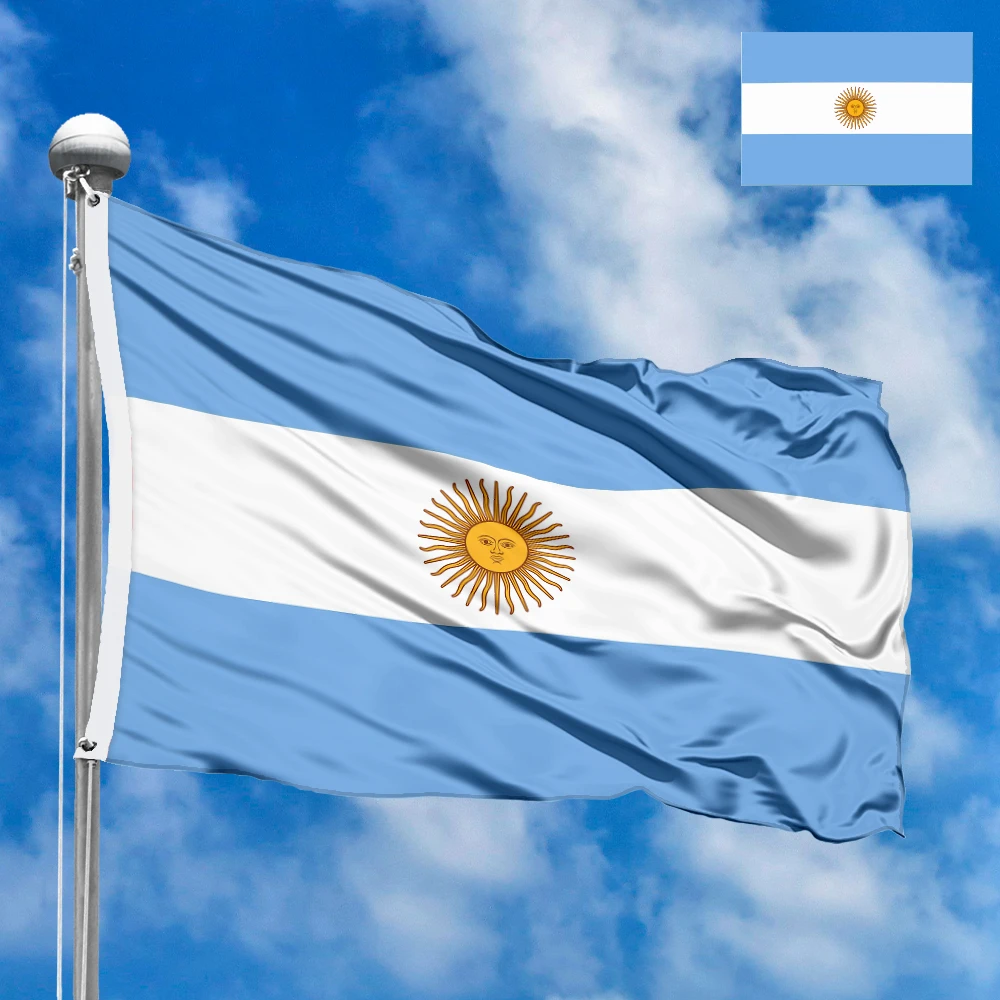The flag of Argentina is one of the most famous and revered national symbols in the world. With its bright blue and white stripes and the iconic "Sun of May" in the center, it is a powerful embodiment of the nation's history, its struggle for freedom, and its deep connection to nature. This flag is not just a piece of cloth but a living story of the May Revolution, heroism, and the pursuit of independence.
A Detailed Look at the Flag's Design and Symbolism
The national flag of Argentina is a horizontal tricolor of light blue, white, and light blue. The top and bottom stripes are a vibrant light blue, and the middle stripe is white. The most distinctive feature of the flag, particularly the official ceremonial version, is the "Sun of May" emblazoned in the center of the white stripe.
Each element of the flag has a deep and inspiring meaning:
-
Light Blue Stripes: The two light blue stripes are said to represent the clear skies of Argentina. They may also symbolize the Río de la Plata, or River Plate, which is a prominent geographical feature of the country. Another historical theory suggests that the colors were inspired by the colors of the Bourbon dynasty, to which the Spanish monarchy belonged.
-
White Stripe: The white stripe represents the clouds and the silver (argentum in Latin), from which the country's name is derived. It symbolizes purity, honesty, and the nation's rich mineral wealth. It is also a reminder of the historical white cockade used by patriots during the May Revolution.
The "Sun of May", a golden emblem with a human face, is the most powerful symbol on the flag. It is a dual symbol, representing:
-
Inti, the Inca Sun God: The sun is a central figure in Inca mythology and represents power and divinity. The sun on the flag is a nod to the region's indigenous heritage and pre-colonial history.
-
The May Revolution: The sun commemorates the May Revolution of 1810, which marked the beginning of Argentina's path to independence from Spanish rule. According to legend, the sun broke through the clouds on that day, and it was seen as an omen of a bright future for the new nation.
The sun has a specific design with 32 rays: 16 straight and 16 wavy, alternating in a circular pattern. This intricate design adds to its unique character.
The History and Creation of the Flag
The history of the Argentine flag is a testament to the nation's struggle for independence. The flag was created by Manuel Belgrano, a lawyer, politician, and military leader, during the Argentine War of Independence. Belgrano believed that the patriots needed a unique flag to distinguish themselves from the royalist forces who used the Spanish colors of red and yellow.
He designed the flag with the light blue and white colors and first raised it on February 27, 1812, in the city of Rosario, on the banks of the Paraná River. Initially, the flag was rejected by the First Triumvirate, who feared it would provoke the Spanish. However, Belgrano defiantly continued to use it.
The flag was officially adopted as the national banner by the Congress of Tucumán on July 20, 1816, shortly after Argentina declared its independence. The "Sun of May" was added to the flag as an official state symbol by the Congress of Tucumán on February 25, 1818. For many years, there were two versions of the flag: the civil flag without the sun and the official ceremonial flag with the sun, which was reserved for public buildings and the military. In 1985, a law was passed that allowed all Argentines to use the flag with the sun.
Meaning and Significance for Residents
For the people of Argentina, the flag is a source of immense national pride and a powerful symbol of their identity. The light blue and white stripes represent the natural beauty of their country and the shared sky that unites them. The flag is a constant reminder of the courage and sacrifice of the heroes of the May Revolution. The Sun of May, in particular, is a source of inspiration, symbolizing the hope and optimism that emerged from the struggle for freedom. The flag is proudly displayed on homes, schools, and public buildings, and is central to national celebrations such as Independence Day (July 9th) and Flag Day (June 20th), the latter of which commemorates the death of Manuel Belgrano. It embodies a shared sense of history, resilience, and the enduring spirit of the Argentine people.
Interesting Facts
-
The colors of the Argentine flag are thought to have been inspired by the blue and white cockades used by patriots in the May Revolution.
-
There are two official versions of the flag: the civil flag, a simple tricolor, and the official ceremonial flag, which includes the "Sun of May." However, since 1985, all citizens are legally permitted to fly the ceremonial flag.
-
The Sun of May is also a symbol on the flags of Uruguay, the two nations sharing a common heritage from the time of the United Provinces of the Río de la Plata.
-
The sun emblem is a replica of a stamp from the first Argentine currency, which was minted in 1813. The sun has a face and 32 rays, half of them straight and half wavy.
-
Flag Day, June 20th, is a significant national holiday in Argentina, dedicated to honoring the flag's creator, Manuel Belgrano, who died on that date in 1820.
In the demonstration images, full-size flags are shown with proportions of 2:3, and hand-held flags with proportions of 1:2.







 Waving flag
Waving flag
 Sizes:
Sizes:
 Round flag
Round flag
 Sizes:
Sizes:
 Rectangular flag 2:3
Rectangular flag 2:3
 Sizes:
Sizes: